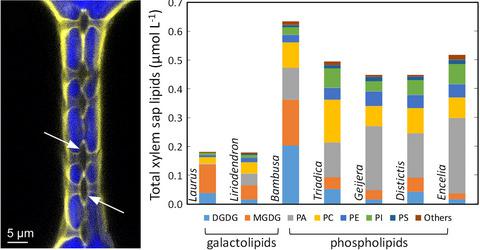Our official English website, www.x-mol.net, welcomes your
feedback! (Note: you will need to create a separate account there.)
Lipids in xylem sap of woody plants across the angiosperm phylogeny
The Plant Journal ( IF 6.2 ) Pub Date : 2020-12-09 , DOI: 10.1111/tpj.15125 H Jochen Schenk 1 , Joseph M Michaud 1 , Kerri Mocko 1 , Susana Espino 1 , Tatiana Melendres 1 , Mary R Roth 2 , Ruth Welti 2 , Lucian Kaack 3 , Steven Jansen 3
The Plant Journal ( IF 6.2 ) Pub Date : 2020-12-09 , DOI: 10.1111/tpj.15125 H Jochen Schenk 1 , Joseph M Michaud 1 , Kerri Mocko 1 , Susana Espino 1 , Tatiana Melendres 1 , Mary R Roth 2 , Ruth Welti 2 , Lucian Kaack 3 , Steven Jansen 3
Affiliation

|
Lipids have been observed attached to lumen‐facing surfaces of mature xylem conduits of several plant species, but there has been little research on their functions or effects on water transport, and only one lipidomic study of the xylem apoplast. Therefore, we conducted lipidomic analyses of xylem sap from woody stems of seven plants representing six major angiosperm clades, including basal magnoliids, monocots and eudicots, to characterize and quantify phospholipids, galactolipids and sulfolipids in sap using mass spectrometry. Locations of lipids in vessels of Laurus nobilis were imaged using transmission electron microscopy and confocal microscopy. Xylem sap contained the galactolipids di‐ and monogalactosyldiacylglycerol, as well as all common plant phospholipids, but only traces of sulfolipids, with total lipid concentrations in extracted sap ranging from 0.18 to 0.63 nmol ml−1 across all seven species. Contamination of extracted sap from lipids in cut living cells was found to be negligible. Lipid composition of sap was compared with wood in two species and was largely similar, suggesting that sap lipids, including galactolipids, originate from cell content of living vessels. Seasonal changes in lipid composition of sap were observed for one species. Lipid layers coated all lumen‐facing vessel surfaces of L. nobilis, and lipids were highly concentrated in inter‐vessel pits. The findings suggest that apoplastic, amphiphilic xylem lipids are a universal feature of angiosperms. The findings require a reinterpretation of the cohesion‐tension theory of water transport to account for the effects of apoplastic lipids on dynamic surface tension and hydraulic conductance in xylem.
中文翻译:

整个被子植物系统发育木本植物木质部汁液中的脂质
已经观察到脂质附着在几种植物成熟木质部导管的内腔表面,但对其功能或对水运输的影响的研究很少,并且只有一项木质部质外体的脂质组学研究。因此,我们对代表六种主要被子植物进化枝(包括基底木兰科、单子叶植物和双子叶植物)的七种植物的木本茎的木质部汁液进行脂质组学分析,以使用质谱法表征和量化汁液中的磷脂、半乳糖脂和硫脂。Laurus nobilis血管中脂质的位置使用透射电子显微镜和共聚焦显微镜进行成像。木质部汁液含有半乳糖脂二-和单半乳糖基二酰基甘油,以及所有常见的植物磷脂,但只有微量硫脂,所有七个物种的提取汁液中的总脂质浓度范围为 0.18 至 0.63 nmol ml -1。发现从切割的活细胞中的脂质中提取的汁液的污染可以忽略不计。将两个物种的树液的脂质成分与木材进行比较,并且在很大程度上相似,这表明包括半乳糖脂在内的树液脂质源自活血管的细胞含量。观察到一个物种树液脂质成分的季节性变化。脂质层覆盖了L. nobilis 的所有面向管腔的血管表面,并且脂质高度集中在血管间凹坑中。研究结果表明,质外体、两亲木质部脂质是被子植物的普遍特征。这些发现需要重新解释水运输的凝聚力-张力理论,以解释质外体脂质对木质部动态表面张力和水力传导的影响。
更新日期:2020-12-09
中文翻译:

整个被子植物系统发育木本植物木质部汁液中的脂质
已经观察到脂质附着在几种植物成熟木质部导管的内腔表面,但对其功能或对水运输的影响的研究很少,并且只有一项木质部质外体的脂质组学研究。因此,我们对代表六种主要被子植物进化枝(包括基底木兰科、单子叶植物和双子叶植物)的七种植物的木本茎的木质部汁液进行脂质组学分析,以使用质谱法表征和量化汁液中的磷脂、半乳糖脂和硫脂。Laurus nobilis血管中脂质的位置使用透射电子显微镜和共聚焦显微镜进行成像。木质部汁液含有半乳糖脂二-和单半乳糖基二酰基甘油,以及所有常见的植物磷脂,但只有微量硫脂,所有七个物种的提取汁液中的总脂质浓度范围为 0.18 至 0.63 nmol ml -1。发现从切割的活细胞中的脂质中提取的汁液的污染可以忽略不计。将两个物种的树液的脂质成分与木材进行比较,并且在很大程度上相似,这表明包括半乳糖脂在内的树液脂质源自活血管的细胞含量。观察到一个物种树液脂质成分的季节性变化。脂质层覆盖了L. nobilis 的所有面向管腔的血管表面,并且脂质高度集中在血管间凹坑中。研究结果表明,质外体、两亲木质部脂质是被子植物的普遍特征。这些发现需要重新解释水运输的凝聚力-张力理论,以解释质外体脂质对木质部动态表面张力和水力传导的影响。











































 京公网安备 11010802027423号
京公网安备 11010802027423号